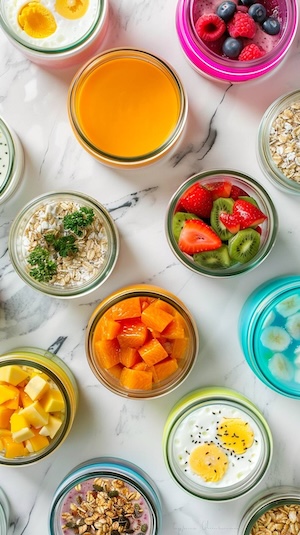PCOS for Picky Eaters: 30 Simple Meal Ideas
Discover 30 simple pcos meals for picky eaters that help manage symptoms. Easy pcos meals picky eaters will love, with practical tips and hormone-balancing ingredients.
This recipe includes superfoods such as:
Transform your health with tailored 7-day meal plans designed specifically for PCOS management. Just $7/month or $59/year.
Get it now →1 pound cultured unsalted butter, such as Plugra, cut into small cubes, plus 1 tablespoon at room temperature
2 cups sugar
3 teaspoons sea salt
4 cups chopped walnuts
2 cups chopped milk chocolate
2 cups chopped dark chocolate
Special equipment: 13-by-18-inch rimmed baking sheet; a candy thermometer; a spider skimmer; long tweezers or a pair of chopsticks
Generously grease a 13-by18-inch rimmed baking sheet with the 1 tablespoon softened butter, making sure to grease the corners of the pan. Set the prepared baking sheet aside on a heat-safe surface, like a large wood cutting board.
Place the remaining 1 pound butter, sugar and 1 teaspoon of the sea salt in a cast-iron skillet set over high heat and whisk occasionally until the butter melts. Reduce the heat to medium-high and cook, whisking frequently, until the mixture has slightly thickened and is tan in color, about 20 minutes. Insert a candy thermometer into the mixture and continue to cook while whisking constantly until the mixture has reached 305 degrees F (the hard crack stage), about 10 minutes.
Using thick oven mitts (the pan will be extremely hot) immediately pour the hot mixture into the prepared baking sheet, tilting it to get an even layer. (Note: Hot sugar syrup will burn and stick to your skin; be careful when pouring to avoid splattering.) Cool the buttercrunch until it is slightly set but still soft, about 5 minutes. Using a knife or bench scraper, score the buttercrunch into 1-inch squares. The score marks will close up while the mixture is still hot, so just keep making the score marks until they remain in place, then let the buttercrunch cool completely, about 1 hour. Break the buttercrunch into pieces along the score lines and place the pieces in a bowl.
While the buttercrunch cools, toast the walnuts: Preheat the oven to 250 degrees F.
Spread the walnuts on a baking sheet and toast them, stirring occasionally, until golden brown and fragrant and the skins are starting to flake, about 45 minutes. Remove the walnuts from the oven and set them aside to cool completely. Place the walnuts in a food processor and pulse until coarsely chopped. Transfer the chopped nuts to a medium bowl and sprinkle the remaining 2 teaspoons of salt over them, tossing to combine.
While the nuts toast, temper the chocolate: Bring a saucepan filled with 1 inch of water to a simmer over medium heat. Reduce the heat to low, add 1 1/2 cups of milk chocolate and 1 1/2 cups of dark chocolate to a large heat-safe bowl, and set it over the hot water (make sure the bottom of the bowl does not touch the simmering water). Melt the chocolate, stirring often, until completely smooth (you can also melt the chopped chocolate in a microwave-safe bowl at 50 percent power, stirring every 1 1/2 minutes until the chocolate is completely melted, 4 to 6 minutes). Remove the chocolate from the saucepan. Off the heat, stir in the remaining chopped milk and dark chocolate a little at a time until the chocolate being added no longer melts into the mass. Once this happens, the chocolate is tempered.
Line a large baking sheet with wax or parchment paper. Set the 3 bowls side-by-side: buttercrunch, chocolate and then the walnuts. Set a spider skimmer next to the bowls with a pair of long tweezers (or chopsticks). Drop a few pieces of the buttercrunch into the chocolate. Use the skimmer to submerge them, then use the skimmer to scoop and lift the buttercrunch out of the chocolate, tapping the skimmer handle on the rim of the bowl a couple of times to drain the excess chocolate. While holding the chocolate in the spider, use your other hand and the tweezers to transfer the chocolate-coated pieces of buttercrunch in the bowl of walnuts. Set the pieces in one by one, and take care so they dont touch one another. Gently sprinkle the walnuts over the dipped buttercrunch pieces to cover them completely, then carefully transfer them to the prepared baking sheet to set completely, about 20 minutes. Repeat with the remaining pieces of buttercrunch.
The Buttercrunch Toffee can be stored in an airtight container at cool room temperature (approximately 65 degrees F.), for up to 2 weeks or in the refrigerator for up to 1 month.
NotesThis recipe was provided by a chef, restaurant or culinary professional and may have been scaled down from a bulk recipe. The Food Network Kitchens have not tested it for home use and therefore cannot make any representation as to the results.

You know the drill: Alarm goes off. You hit snooze. Rush around frantically. Skip breakfast AGAIN because there's no time. By 10am, you're hangry, your blood sugar is all over the place, and your PCOS symptoms are already acting up.
Sound familiar?
Finally – a meal prep system designed specifically for women with PCOS who refuse to let chaotic mornings derail their health goals.
In just ONE hour on Sunday, you can transform your entire week:
"I went from skipping breakfast 4 days a week to having delicious, hormone-supporting meals ready every morning. My energy is more stable and my cravings have disappeared!"
– Sarah M.
Stop letting chaotic mornings control your health.
Get your hormone-happy mornings starting this Sunday.
→ Get Your 60-Minute Solution Now
Transform your health with tailored 7-day meal plans designed specifically for PCOS management. Just $7/month or $59/year.
Get it now →Serving Size: 0
| Amount Per ONE Serving | ||
|---|---|---|
| Calories 0 kcal | ||
| Fat 0 g | ||
| Carbohydrate 0 g | ||
| Protein 0 g | ||
💡 Introducing the 10/10 PCOS Solution:
Ten Delicious Crockpot Recipes that take just 10 minutes to prep!
Say goodbye to hours in the kitchen and hello to clean, PCOS-friendly meals made effortlessly.
👉 Click here to grab your 10/10 PCOS Solution today! Try The 10/10 PCOS Solution: Ten Crockpot Recipes That Take Just Ten Minutes to Prep
Managing PCOS can be challenging, but you don't have to do it alone. Join our supportive community to connect with others who understand what you're going through, share tips, and get encouragement. Here's how you can get involved:
Subscribe to our Newsletter: Receive PCOS-friendly recipes, tips, research updates, and more delivered straight to your inbox. Stay informed and empowered with the latest information and support.
Join our Telegram Channel: Stay updated with the latest tips and advice on managing PCOS.
Follow PCOS Meal Planner on Facebook: Engage with our community, participate in discussions, and get support from others.
Break the cycle with the PCOS Meal Planner - your personalized guide to eating better, feeling better, and managing PCOS symptoms. Take control today!

Forget the frustrating cycle of weight loss attempts, endless medications, and living in discomfort. Introducing the PCOS Meal Planner. A meal planning guide that goes beyond temporary fixes to offer a comprehensive strategy, empowering you to ignite a transformation towards lasting health and happiness. Step into a world where you control your PCOS, not the other way around.
Unlock Your PCOS Freedom Now.
Discover 30 simple pcos meals for picky eaters that help manage symptoms. Easy pcos meals picky eaters will love, with practical tips and hormone-balancing ingredients.
Discover 15 delicious overnight oats for PCOS recipes that help balance hormones and manage symptoms. Easy, nutritious breakfast ideas perfect for women with PCOS.
Discover the best cereal for PCOS with our expert rankings. Compare brands, check ingredients, and find PCOS friendly cereal that supports hormonal balance.
Learn how to transition away from fruit when starting a ketogenic diet for PCOS. Discover gradual strategies, fruit alternatives, and practical tips for success.
Discover 5 delicious PCOS banana bread recipes with low-glycemic ingredients. Learn how to make hormone-friendly banana bread that supports blood sugar balance.
Creatine for women with PCOS explained simply. Learn safety, benefits, hormone effects, tips, and how creatine may support PCOS symptoms naturally.
Complete PCOS diet plan with foods to eat, foods to avoid, meal timing, and real results. Learn the science-backed approach to managing PCOS through diet, with 7-day meal plan, grocery list, and step-by-step implementation guide. Based on clinical research and real patient outcomes.
Complete guide to ordering at Wendy's with PCOS. Discover the best protein-focused meals, what to skip, and how to customize orders to keep blood sugar stable. Learn which burgers, salads, and sides work for PCOS, plus complete macros for every menu item and smart swaps to avoid insulin spikes.
Complete guide to ordering at Burger King with PCOS. Discover the best protein-focused meals, what to skip, and how to customize orders to keep blood sugar stable. Learn which burgers, salads, and sides work for PCOS, plus complete macros for every menu item and smart swaps to avoid insulin spikes.